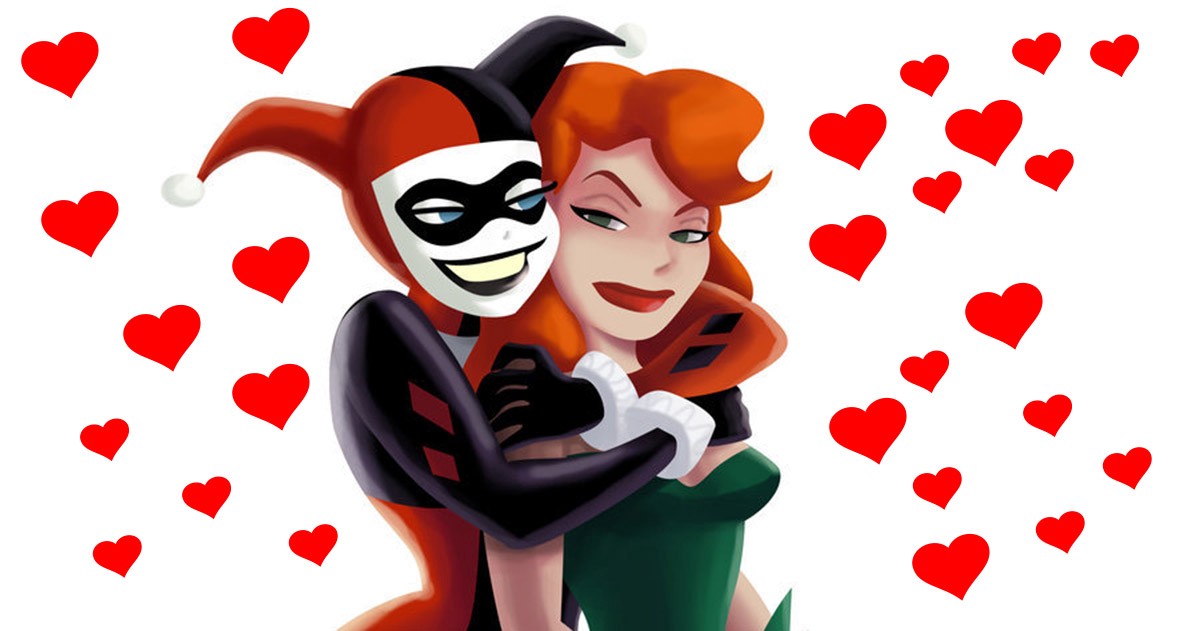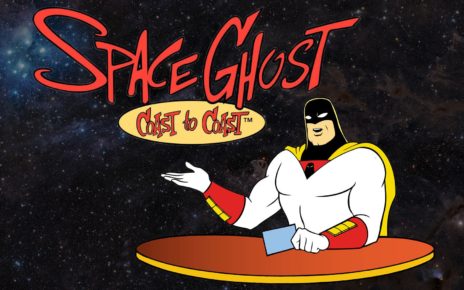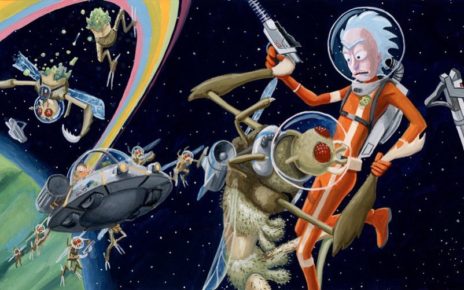A buxom, green-clad redhead and her wisecracking, pigtailed partner in crime pull up to a stoplight in a pink car named “Rose Bud.” A group of ogling, catcalling bros yells, “Well, hello — I think I’m in loooove.”
The redhead demurs, “Excuse me, boys. Didn’t your mommies teach you that’s not a nice way to get a lady’s attention?” When one of the jokers responds, “And what are you gonna do — spank us?” our favorite clown pulls out her bazooka with a look of disgust, levels it straight at the boys’ car, and says, “That’s right, pigs — and here’s the paddle!” Then she blasts the car to bits. This is Harley Quinn and Poison Ivy of Batman: The Animated Series. They’re bad, they’re beautiful, and they are absolutely in love with each other and with the lives they’ve chosen.
The “New Queens of Crime,” as the Gotham city papers dubbed them in the show, represented a bold step forward in the superhero/supervillain universe. Harley and Ivy’s dynamic begins as an empowering, feminist friendship and blossoms into something more — a relationship that is coded but later explicitly addressed as lesbian, and one that helps Harley Quinn escape from her abusive boyfriend, the Joker. Their relationship endures to this day, and will hopefully be featured in the upcoming Gotham City Sirens film.
The scene above is from the episode “Harley and Ivy,” which introduced the couple to the Batman mythos. After Poison Ivy attempts to run from the same heist, Harley joins forces with her and they both escape the cops with exactly what they want. They exchange high fives — a common victory gesture for the two of them — as Poison Ivy declares, “This could be the beginning of a beautiful friendship.” And indeed it is. Numerous episodes of the show, including the rest of “Harley and Ivy” as well as “Girls’ Night Out” and “Holiday Knights,” chronicle their reign as the most destructive duo in Gotham City and their attempts to draw fellow female villains into their circle (e.g., Livewire in “Girls’ Night Out” and Nails in the Static Shock episode “Hard as Nails”). The comics now portray their relationship as official, while Batman: The Animated Series could only hint at it. Still, for a children’s cartoon in the ’90s, their rapport was nothing short of revolutionary.
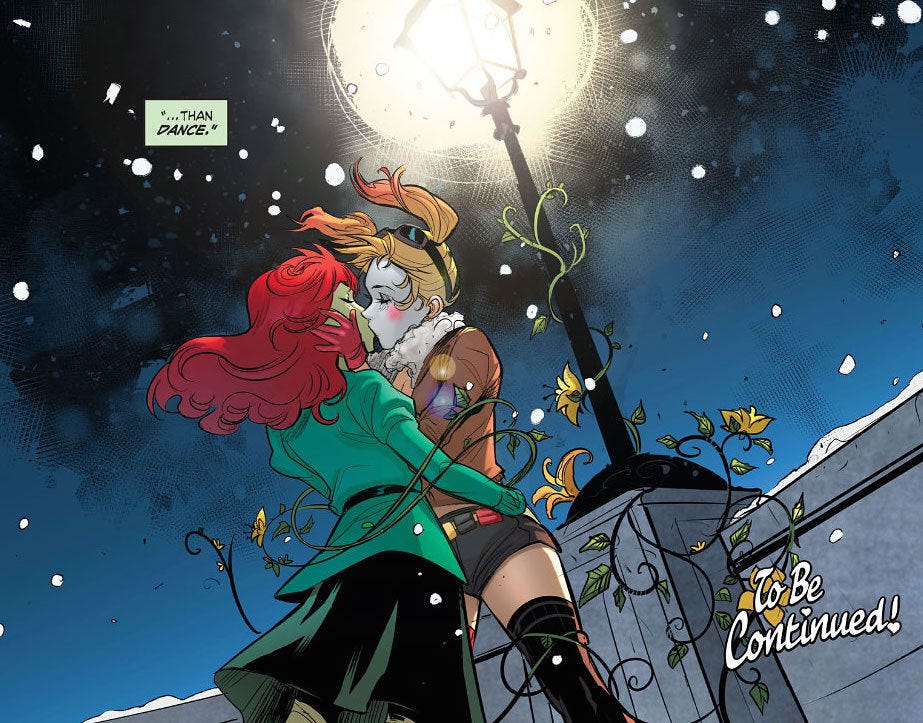
Staff culture writer for New York magazine Abraham Riesman, who has written extensively about the Batman characters, agrees. “One of the most interesting aspects of the Harley/Ivy pairing is that the characters are both sexually fluid,” says Riesman. “The concept of bisexuality was still extremely novel in popular culture as of [“Harley and Ivy”]’s 1993 airdate, but now, it’s taken more or less as a given that sexual attraction is a glorious moving target.”

One chaotic element mars Harley Quinn’s bisexuality, of course: the Joker. Her lingering obsession with him can only hurt her. Though the Joker has manipulated her, berated and belittled her, lied to her over and over, and physically harmed her, Harley still “loves” and misses her “Pudd’n.” Ivy pushes her to break away from this cycle of abuse, showing her what a real partner looks like by providing her a space to grow while questioning what exactly it is that she misses: “You wanna be some wacko’s victim the rest of your life?”
Yes, they are Girlfriends without the jealousy of monogamy. @jpalmiotti @AmandaRantsAlot #HarleyQuinnChat https://t.co/n86jApADCi
Clearly Warner Bros. feels that dynamic — of empowered women looking out for each other, even if they’re supervillains — is a marketable one. Gotham City Sirens presents Warner Bros. and DC with a new opportunity for the filmmakers to delve into the Harley and Ivy romance and present it onscreen as its been treated in the comics. At a time when those who love outside what is considered “the norm” fear for their rights and protections, when fears of executive orders rolling back progress for the LGBT community abound, a strong statement could be made by featuring a healthy lesbian relationship onscreen. Riesman, for his part, is all for it.
“For many who grew up in the 1990s, ‘Harley and Ivy’ is an Ur-text for queer sexuality, and it would be a shame to erase its influence from Gotham City Sirens,” Riesman says. “Doing a Harley and Ivy story without queerness is like doing a Batman story without dead parents.”
After all, if someone finds that kind of love with another — the kind that makes them better and stronger, the kind that pushes them to find their voice and believe in themselves, the kind that is always punctuated by a victory high five after a good heist — why try to hide or delegitimize that love? Wouldn’t that be the real crime?
It would be great for mainstream audiences to see that when all is said and done, Harley doesn’t need her “Pudd’n” — all she needs is a little Poison.
“When they get together, it’s a reminder that there is nothing concrete about attraction,” Riesman says. “We simply love who we love.”
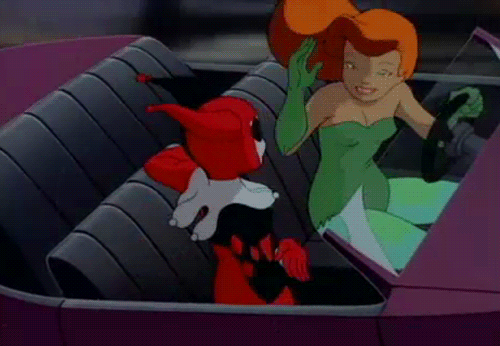
Thanks for reading The Dot and Line, where we talk about animation of all kinds. Don’t forget to ❤ this article and follow us on Twitter and Facebook.


